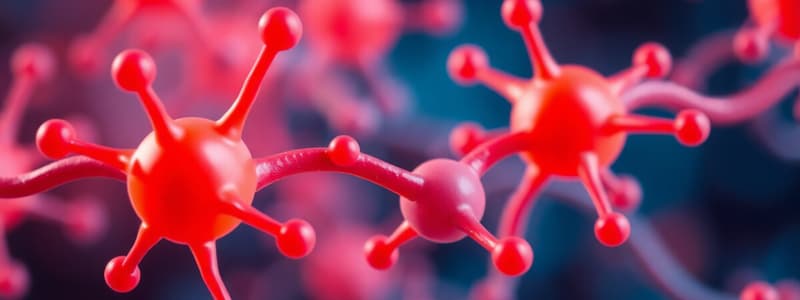Podcast
Questions and Answers
A patient with severe liver impairment requires a benzodiazepine for anxiety. Which of the following benzodiazepines would be most appropriate?
A patient with severe liver impairment requires a benzodiazepine for anxiety. Which of the following benzodiazepines would be most appropriate?
- Lorazepam (correct)
- Clonazepam
- Diazepam
- Chlordiazepoxide
Why are benzodiazepines safer than barbiturates in overdose situations?
Why are benzodiazepines safer than barbiturates in overdose situations?
- Benzodiazepines are rapidly metabolized, reducing their duration of effect compared to barbiturates.
- Benzodiazepines increase the duration of chloride channel opening, while barbiturates increase the frequency.
- Benzodiazepines have a lower affinity for GABA-A receptors than barbiturates, resulting in a ceiling effect.
- Benzodiazepines do not open chloride channels alone; GABA must be present, while barbiturates can directly open chloride channels. (correct)
A patient is administered flumazenil following a benzodiazepine overdose. Shortly after administration, the patient experiences a seizure. What is the most likely underlying mechanism?
A patient is administered flumazenil following a benzodiazepine overdose. Shortly after administration, the patient experiences a seizure. What is the most likely underlying mechanism?
- Flumazenil's antagonism of benzodiazepines at the GABA-A receptor precipitates withdrawal, lowering the seizure threshold. (correct)
- Flumazenil's rapid metabolism causes a rebound effect, exacerbating the benzodiazepine overdose.
- Flumazenil increases the concentration of glutamate, an excitatory neurotransmitter, in the central nervous system.
- Flumazenil directly inhibits GABA-B receptors, leading to increased neuronal excitability.
Which of the following describes how benzodiazepines influence the GABA-A receptor?
Which of the following describes how benzodiazepines influence the GABA-A receptor?
A patient with a history of alcohol abuse is admitted for delirium tremens. Which benzodiazepine would be most appropriate for managing their withdrawal symptoms, considering the patient's history?
A patient with a history of alcohol abuse is admitted for delirium tremens. Which benzodiazepine would be most appropriate for managing their withdrawal symptoms, considering the patient's history?
A researcher is studying the effects of a novel compound on GABA-A receptors. The compound increases chloride influx into neurons, but only in the presence of GABA. Which mechanism of action does this compound most likely exhibit?
A researcher is studying the effects of a novel compound on GABA-A receptors. The compound increases chloride influx into neurons, but only in the presence of GABA. Which mechanism of action does this compound most likely exhibit?
A patient reports experiencing significant daytime anxiety and occasional night terrors. Considering the range of benzodiazepines, which of the following would be the LEAST appropriate choice for this patient's combined symptoms?
A patient reports experiencing significant daytime anxiety and occasional night terrors. Considering the range of benzodiazepines, which of the following would be the LEAST appropriate choice for this patient's combined symptoms?
A patient is prescribed a benzodiazepine to manage anxiety related to an upcoming surgery. The patient is concerned about experiencing memory loss. Which GABA-A receptor subunit-specific effect is most closely associated with anterograde amnesia?
A patient is prescribed a benzodiazepine to manage anxiety related to an upcoming surgery. The patient is concerned about experiencing memory loss. Which GABA-A receptor subunit-specific effect is most closely associated with anterograde amnesia?
Why are benzodiazepines classified as positive allosteric modulators of the GABA-A receptor rather than direct agonists?
Why are benzodiazepines classified as positive allosteric modulators of the GABA-A receptor rather than direct agonists?
A geriatric patient is prescribed a benzodiazepine for short-term anxiety management. Considering age-related physiological changes, which factor is MOST critical to consider when selecting an appropriate benzodiazepine and its dosage?
A geriatric patient is prescribed a benzodiazepine for short-term anxiety management. Considering age-related physiological changes, which factor is MOST critical to consider when selecting an appropriate benzodiazepine and its dosage?
Following a traumatic event, a patient is experiencing severe panic attacks and is prescribed a benzodiazepine for short-term relief. What aspect of benzodiazepine pharmacology is MOST relevant to consider in order to minimize the risk of dependence?
Following a traumatic event, a patient is experiencing severe panic attacks and is prescribed a benzodiazepine for short-term relief. What aspect of benzodiazepine pharmacology is MOST relevant to consider in order to minimize the risk of dependence?
A patient is taking a benzodiazepine and reports experiencing increased anxiety and agitation, rather than the expected calming effect. What is the MOST likely explanation for this paradoxical reaction?
A patient is taking a benzodiazepine and reports experiencing increased anxiety and agitation, rather than the expected calming effect. What is the MOST likely explanation for this paradoxical reaction?
A patient with insomnia is prescribed a benzodiazepine. They also have a history of sleep apnea. What is the major concern regarding the use of benzodiazepines in this patient?
A patient with insomnia is prescribed a benzodiazepine. They also have a history of sleep apnea. What is the major concern regarding the use of benzodiazepines in this patient?
A researcher is investigating the effects of different benzodiazepines on specific GABA-A receptor subtypes. Which of the following best describes the relationship between the α2 and α3 subunits and the therapeutic effects of benzodiazepines?
A researcher is investigating the effects of different benzodiazepines on specific GABA-A receptor subtypes. Which of the following best describes the relationship between the α2 and α3 subunits and the therapeutic effects of benzodiazepines?
A patient is prescribed lorazepam for anxiety. They also take an opioid medication for chronic pain. What is the primary concern regarding this combination of medications?
A patient is prescribed lorazepam for anxiety. They also take an opioid medication for chronic pain. What is the primary concern regarding this combination of medications?
A patient with known panic disorder has been using alprazolam daily for several months. What is the MOST critical consideration when discontinuing this medication?
A patient with known panic disorder has been using alprazolam daily for several months. What is the MOST critical consideration when discontinuing this medication?
A patient is brought to the emergency department with suspected benzodiazepine overdose. The patient is responsive but has shallow breathing and is increasingly drowsy. After administering an initial dose of flumazenil, there is no significant improvement in respiratory function. What is the MOST appropriate next step?
A patient is brought to the emergency department with suspected benzodiazepine overdose. The patient is responsive but has shallow breathing and is increasingly drowsy. After administering an initial dose of flumazenil, there is no significant improvement in respiratory function. What is the MOST appropriate next step?
A patient has been prescribed midazolam for preoperative sedation. What is the primary reason this particular benzodiazepine is chosen for this purpose compared to other benzodiazepines?
A patient has been prescribed midazolam for preoperative sedation. What is the primary reason this particular benzodiazepine is chosen for this purpose compared to other benzodiazepines?
A researcher is developing a new drug that selectively targets the α5 subunit of the GABA-A receptor. What is the most likely therapeutic application of this drug?
A researcher is developing a new drug that selectively targets the α5 subunit of the GABA-A receptor. What is the most likely therapeutic application of this drug?
A patient is taking a benzodiazepine for anxiety and reports experiencing frequent falls. What is the MOST likely mechanism by which benzodiazepines increase the risk of falls?
A patient is taking a benzodiazepine for anxiety and reports experiencing frequent falls. What is the MOST likely mechanism by which benzodiazepines increase the risk of falls?
Flashcards
Benzodiazepine Classification
Benzodiazepine Classification
BZDs are categorized by how long their effects last: short, intermediate, and long-acting.
BZD Mechanism of Action
BZD Mechanism of Action
BZDs enhance GABA's effect by increasing the frequency of chloride channel opening, which inhibits neuronal excitability.
Common BZD Indications
Common BZD Indications
Anxiety, insomnia, seizures, withdrawal, muscle relaxation, and anesthesia.
Common BZD Side Effects
Common BZD Side Effects
Signup and view all the flashcards
BZD Overdose Antidote
BZD Overdose Antidote
Signup and view all the flashcards
Short-Acting BZDs
Short-Acting BZDs
Signup and view all the flashcards
Intermediate-Acting BZDs
Intermediate-Acting BZDs
Signup and view all the flashcards
Long-Acting BZDs
Long-Acting BZDs
Signup and view all the flashcards
LOT Drugs
LOT Drugs
Signup and view all the flashcards
BZD Binding Site
BZD Binding Site
Signup and view all the flashcards
GABA requirement for BZDs
GABA requirement for BZDs
Signup and view all the flashcards
α1 Subunit Effects
α1 Subunit Effects
Signup and view all the flashcards
α2/α3 Subunit Effects
α2/α3 Subunit Effects
Signup and view all the flashcards
α5 Subunit Effects
α5 Subunit Effects
Signup and view all the flashcards
Target of Benzodiazepines
Target of Benzodiazepines
Signup and view all the flashcards
Study Notes
- Benzodiazepines (BZDs) are categorized by duration: short, intermediate, and long-acting.
Duration of Action
- Short-acting BZDs include midazolam (2–6h) and triazolam (2–6h).
- Lorazepam (6–24h) is an intermediate-acting BZD.
- Clonazepam (>24h) is a long-acting BZD.
Mechanism of Action
- BZDs bind between the alpha-1 and gamma-2 subunits on the GABA-A receptor.
- GABA binds to GABA receptors, opening chloride channels.
- Chloride influx causes hyperpolarization, hindering neuron depolarization.
- BZDs boost the frequency of chloride channel opening when GABA is present, amplifying inhibitory signals.
- BZDs function as positive allosteric modulators on GABA-A receptors.
Indications
- BZDs treat anxiety disorders, insomnia, status epilepticus, night terrors, withdrawal, anesthesia, and muscle spasms.
- They address generalized anxiety disorder, panic attacks, and short-term insomnia.
- Lorazepam and diazepam are used for status epilepticus.
- Chlordiazepoxide and diazepam manage alcohol withdrawal/delirium tremens.
- Diazepam is a treatment for muscle spasticity.
- Midazolam induces preoperative sedation.
- BZDs, when combined with antipsychotics, can treat acute agitation or mania.
Side Effects
- Common side effects include sedation, confusion, CNS depression, paradoxical stimulation, anterograde amnesia, respiratory depression, and coma.
- Cognitive impairment, muscle weakness, ataxia, and falls are other side effects, especially in the elderly.
- Prolonged use can lead to dependence and tolerance.
Contraindications
- BZDs are not advised in cases of respiratory depression, myasthenia gravis, pregnancy/breastfeeding, and severe liver impairment.
- Caution is needed with elderly patients because of increased fall and confusion risks.
- Pregnancy is contraindicated due to teratogenic effects like cleft palate and floppy infant syndrome.
- Substance abuse history is a contraindication because of dependence risk.
- Use with caution in patients with severe respiratory insufficiency or sleep apnea.
- Lorazepam, oxazepam, and temazepam (LOT) are safer choices in hepatic impairment.
Overdose Antidote
- Flumazenil is the antidote for BZD overdose with an initial dose of 0.2 mg.
- Maximum dose of Flumazenil per cycle is 1 mg because it may cause seizures/arrhythmias.
Common Benzodiazepines
- Short-acting BZDs (t½ < 6 hrs): triazolam, midazolam
- Intermediate-acting BZDs (t½ 6–24 hrs): lorazepam, temazepam, oxazepam, alprazolam
- Long-acting BZDs (t½ > 24 hrs): diazepam, clonazepam, chlordiazepoxide, flurazepam
Mnemonic
- "TOM and AL’s Long Cool Dudes" aids recall of drug categories
- Triazolam, Oxazepam, Midazolam: short/intermediate
- Alprazolam, Lorazepam: intermediate
- Long-acting: Clonazepam, Diazepam
- LOT drugs (safe in liver disease, metabolized via conjugation): Lorazepam, Oxazepam, Temazepam
Mechanism of Action (Detailed)
- BZDs are positive allosteric modulators of the GABA-A receptor.
- They bind at the interface between the α and γ subunits on the GABA-A receptor complex.
- Binding increases the frequency of chloride (Cl⁻) channel opening in the presence of GABA; GABA is required.
- Increased Cl⁻ influx leads to hyperpolarization of the neuron, decreasing excitability.
- They enhance GABA’s inhibitory effect but do not mimic it, making them safer than barbiturates in overdose.
Subunit Specific Effects:
- The GABA-A receptor is a pentamer (5 subunits), typically 2α, 2β, 1γ.
- α1 subunits are related to sedation, amnesia, and anticonvulsant effects.
- α2 and α3 subunits are related to anxiolysis and muscle relaxation.
- α5 subunits are related to cognition, learning, and memory.
Receptor Binding Summary
- BZDs do not affect GABA-B receptors, which are metabotropic; instead, they act only on ionotropic GABA-A receptors.
- BZDs do not open Cl⁻ channels alone; GABA must be present.
- Synergistic effects occur with alcohol, opioids, and barbiturates.
Studying That Suits You
Use AI to generate personalized quizzes and flashcards to suit your learning preferences.





